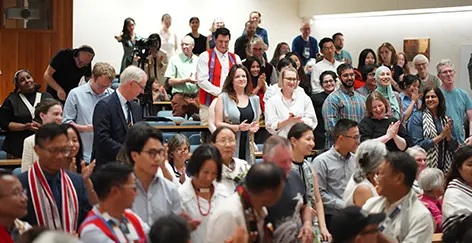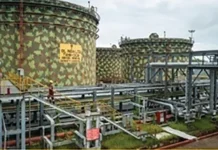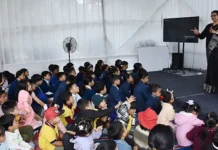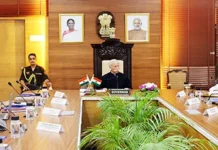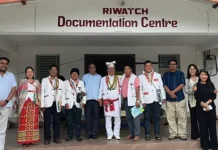OXFORD, 15 Jun: The Naga delegation, comprising senior leaders of Naga tribe hohos from Naga territories, the Forum for Naga Reconciliation (FNR), and the Recover, Restore, and Decolonise (RRaD)team, concluded a weeklong series of events and activities aimed at repatriating ancestral human remains from the Pitt Rivers Museum (PRM) at Oxford University on 13 June.
The Naga delegation met with representatives from various British museums that held Naga belongings and human remains. Dr Alexandra Green, curator of the British Museum, stated that a significant amount of material from Myanmar/Burma may be of importance to the Nagas, but much of the existing collection was obtained from the erstwhile province of Assam.
Dr Mark Elliot, senior curator of the Museum of Archaeology and Anthropology at Cambridge University, informeD that only a small percentage of the material was on display; hence, his university was also trying to digitise the material for greater public accessibility. He said that there were 725 objects, mainly belonging to the Angami, Ao, Konyak, and Khiamniungan communities.
The head of exhibitions and collections at Manchester University, Georgina Young, and the lead curator of the South Asia gallery, Nusrat Ahmed, informed the Naga delegation that they have been working tirelessly with local South Asian communities to co-create what should be included in the galleries and how they should be represented. They informed the Nagas that they possessed twelve Naga human remains, eleven of which were from the Konyak areas. The materials were donated by James P Mills, and in 1994, the Board of Manchester University decided that all the human remains were to be removed from the exhibition.
Navjot Mangat and Heba Abd El Gawad, representatives of the Horniman Museum in London, informed the Naga audience that they had stopped using the word ‘objects’ and had begun to use ‘belongings’ to refer to the material that was forcibly taken from communities during colonial rule. They said that they have more than 400 belongings, mainly pipes and shawls, most of which were obtained as gifts from army officers stationed in the Naga homelands during colonial times. They still have two human remains that had been taken off display. They said they would like to work with the Naga community to ensure that there could be an ethical process to repatriate human remains and belongings.
Lisa Graves, the curator of the Bristol Museum, said that they had more than 200 potential Naga collections and one trophy head that had been removed from display. A lot of their material from Myanmar had been labelled as belonging to the Chin, but it is possible that they were mislabelled.
Following these presentations, Prof Arkotong Longkumer initiated an open public event at the lecture hall of the Museum of Natural History, Oxford University. Beginning with a one-minute silence for the victims of the tragic air disaster in Ahmedabad, he welcomed Kumsang Bendangtoshi, presidential council member, and Tongor Luden Ao Senden to dedicate the proceedings to the ancestors and spirits. After the dedication, Dr Laura van Broekhoven, director of the Pitt Rivers Museum, remarked that the weeklong discussions with the Naga delegation had been fruitful. This marked the culmination of five years of engagement that enabled the transition from preservation care to the cultural care of human remains and other belongings.
Dr Visier Sanyu offered a traditional chant that alluded to the separation of the ancestors from the creator and prayed that the two could be reunited to heal the hurts of the past and present.
Thejao Vihienuo, president, Angami Public Organisation, read out The Naga Oxford Declaration on Repatriation that stated that -as Nagas, we do so in a united voice, with mutual respect and consensus and to offer you a dignified rest, establishing a Naga monument of healing and peace for all generations, symbolising the oneness of the Nagas.
The declaration was then presented to Dr Laura van Broekhoven, the director of PRM.
Observing the increase in violence, fragmentation, and polarisation across the world, Dr Aküm Longchari asked, “What does it mean to dream and imagine again?” He stated, “… (there is a) need for us to imagine the interplay of humanisation, justpeace and healing, as the embodied aspirations of the people, as a process to address the turbulence of the world today.”
He emphasised that healing for the Nagas is central, particularly when addressing the historical trauma passed down from one generation to another. “The pathways of truth-telling, forgiveness, and redemption need to occur within the process of mutual healing to reclaim our identities, histories, and destinies”, he added. He urged Oxford University to envision an emancipatory process for humanisation where repatriation, healing, and decolonisation intersect in the reclaiming of the past, present and future. In this context, he questioned whether the university could move from its colonial past and become a place for healing and justice across cultures, with the PRM as the fulcrum.
Rev Dr Ellen Konyak Jamir explained the journey of the Recover, Restore, and Decolonise (RRaD) initiative concerning their involvement in the dialogue on repatriation. She informed the audience about the challenging circumstances that the team had to overcome in order to connect with grassroots and engage various stakeholders in the process.
The event concluded with Professor Dolly Kikon’s reflections on the weeklong deliberations and the discussion of the way forward. Stating that she perceived the gathering as one filled with friends, mentors, and allies, Kikon said: “Through the repatriation process, we are creating a new truth and marching towards new promises of peace and a shared future.” She urged the audience to commit to the journey towards new pedagogies that centre on co-learning, co-creation, and, for a change, listening to the indigenous people shepherding the process. “Who would have thought of a day when the descendants of ancestors strung on the walls of this museum would travel thousands of kilometres to talk about humanisation? Who would have thought of a day, since the Pitt Rivers Museum was established in 1884,
that the Naga people would arrive here and reclaim their ancestors and seek joint custodianship of their cultural artefacts?” she asked. “Colonisation was a project of division,” she said and thereafter concluded by asserting to let the Naga repatriation process and all repatriation processes around the world to give dignity to ancestors to shine and be “a beacon of knowledge that aligns with humanity, humility, care, healing, courage, liberation, and inclusivity.”

